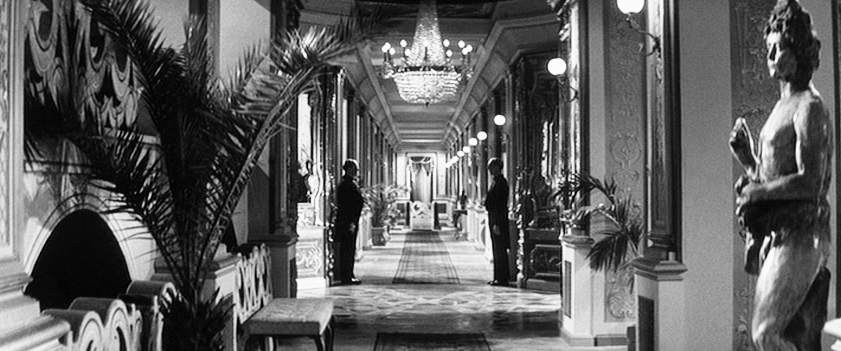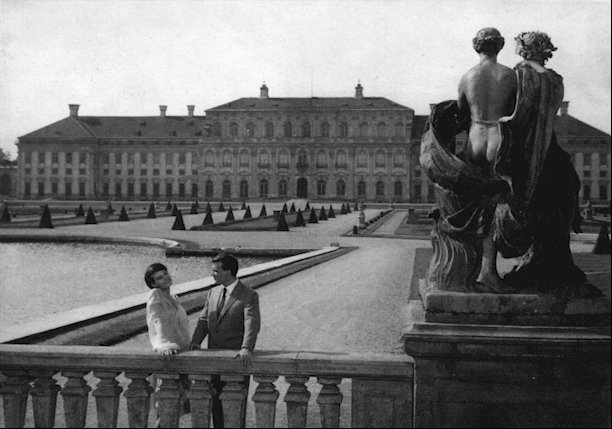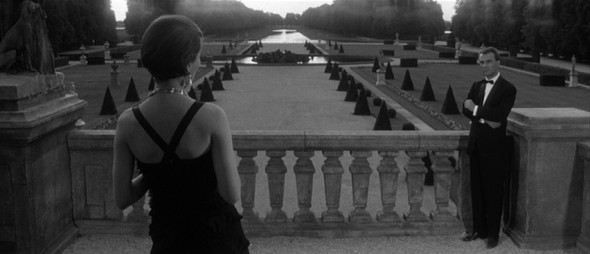Last Year at Marienbad is proof that the choose-your-own-adventure film construction was popular long before Black Mirror: Bandersnatch had convinced people that this will be the newest emerging format for film. For it is in Last Year at Marienbad where audiences are offered countless paths to follow, choosing the version of the story they appreciate most. Alain Resnais achieved this possibility with his 1961 film, a defining work of The French New Wave as well as an enduring example of modern art.
The confounding film which stars two people—inextricably drawn to each other—who may or may not have met each other before. Even their names, X (Giorgio Albertazzi) and A (Delphine Seyrig) call to mind an algebraic equation that hasn’t yet been solved, the perfect metaphor for the film. For those that haven’t seen Last Year at Marienbad, don’t expect a linear narrative, easy to understand. Quite conversely what audiences can expect are several stories, repeated throughout the runtime of the film, some wildly different, others with only slight changes all told by X in a desperate attempt to get A to remember a meeting he is desperate to convince her took place. Did the two meet, or is this perhaps simply a case of an unreliable narrator? The audience can’t say by the conclusion of the film; there is plenty of evidence to fill in whichever route a viewer wishes to take. Nearly every time X speaks to A, he is talking to her in the 2nd person, changing his story when he convinces himself that she will remember it if told a different way. He is essentially telling her story both to her and for her through his language techniques. If the narrator is believed to be reliable, then the possibilities are even broader as to what history exists between these two people. They may be lovers, forbidden lovers, strangers. Their story may be a fantasy, a tragedy, one inspired by fear, passion, or even death. Through the rich narrative power infused into two characters that the audience hardly gets the chance to know, yet profoundly explores, viewers are able to follow the reminiscences presented to them and create a story from a dream.

Whatever ambiguity Alain Resnais sought to keep when discussing Last Year at Marienbad, it is evident through the precision and care that he took to bring the film to fruition that he had great respect and a controlled vision of the film he was creating. All art carries with it a meaning unique to the individual and is further expanded by the various perspectives each person brings to their experience with the art. Resnais is in such complete command of his subversive material throughout the entire film; he offers the audience no choice but to be pulled into the mystery, as he slowly provides additional pieces of the puzzle even to the most increasingly impatient viewer. This assuredness led to Resnais’ ability to film the physical construction of the space between dreams and memories. His spellbinding, swooping camera gently glides over the ornate flourishings of the luxury hotel acting as the skeleton of the film and produces an endless treasure trove of influence to a countless number of films that followed it.
Despite any difficulties one may have in following the narrative structure of Last Year at Marienbad, one can nevertheless see certain themes emerge throughout the film. The film calls to mind a famous quote by a fellow figure of The French New Wave Jean-Luc Godard, who said “A story should have a beginning, a middle and an end, but not necessarily in that order”, and a coherent order is certainly not what one gets out of a viewing of Last Year at Marienbad.
Visually stunning, the tidy gardens with sharply-trimmed hedges in geometric patterns, the French Baroque garden design perfectly adding to the sense of illusion and mystery the film presents are repeatedly referenced. “Behind walls with more walls, you don’t know what I went through to get you” X shares with A, in a plea inspire within her a memory to his existence as a part of her life. So desperate is X that he alters his and A’s memories of events that may have never occurred, just as one changes their path through a maze once they realized they had hit a dead end, committed to trying another way that will lead to their desired goal. So too is the word frozen repeated many times throughout the film which calls to mind the many times our protagonists halt their stance and assume statuesque poses as if they are as frozen in time as their memories.

Statues were prevalent themes throughout The French New Wave. A Statue famously haunts the memories of the two best friends in François Truffaut’s film about a triangular love, Jules and Jim. Maintaining the triangularity in Last Year at Marienbad is M (Sacha Pitoëff) the figure who may be the lover, husband, caretaker, or authority over A. Whatever M’s place is in the film, he is an obstruction to any possible union between A and X, he is yet another wall struck in a maze signifying a dead end. When X and A are afforded time together, it is mostly spent in the gardens. Often, they are conversing about the statues near them, their different interpretations of the statue’s stories, and how they may relate to their own.
Another consistent theme throughout the film is a focus on the impermanence of life and human relationships. Just as the hotel rooms are filled with people who then leave, so too are our lives filled with people who will eventually become only a memory. If A was indeed in X’s life, it is not someone he wants to leave solely in the place of mind, yet his constantly changing recollection calls into question his memory and if he is recalling or constructing the past. The ornate statues and figures decorating the halls and walls of the chateau “see” guests walking through the hotel that their comings and goings blur together until it can no longer be discerned who is who. The human memory is easily altered, and memories are not stored in an unchangeable lockbox as we imagine. In fact, memories change and are molded by our perceptions, including how those perceptions are changed over time. Last Year at Marienbad not only explores the often temporary connections people make but also the mechanism by which we keep those memories.

Just as Last Year at Marienbad may have something compelling to offer about life and those that accompany us throughout the journeys of our existences, so too does it seem to have a powerful meditation on death, as well. Many allusions to death can be perceived throughout the film. In some scenes, X is dressed in black and A in all white, creating a life/death, angel/devil visual illusion. Near the end of the film, X says to A, “you were losing your balance forever with me,” perhaps the way someone’s soul transfers clumsily from life to death. Just like the game we see played throughout the film, which seemingly cannot be won, neither can the game of life once the grim reaper decides to follow you.
No matter what A does, or how insistently she tries to convince X that she can’t remember, he persists and follows her as if on a mission that he cannot complete until she goes with him in a way that seems to relate to a space in eternity after human life ends. Perhaps, too, that is why A does not want to follow X, because it would be an acceptance of an end to her life. Whether or not any death-like reference was intended throughout the film, it is undoubtedly a read for which such evidence exists.
We are continually asking questions throughout life, questions that we are unable to uncover the answers for, questions to which only time could offer a response. Instead of being frustrated by the lack of answers throughout life, or, a viewing of Last Year at Marienbad, we are wise to recognize that a question without a solution is a possibility. Life holding back the pieces of the puzzle that we need to make out what has happened throughout our lives offer a chance for change, a redirection of our paths and alterations to our existences. Our desires are often only satisfied with an immediate response, and Last Year at Marienbad‘s reflection on human behavior and how we experience desire provides for a new way to recognize how dependent we are upon instant gratification and to remind us how fulfilling it can be to restore our patience.
Such meditation on life through art makes Last Year at Marienbad much more than entertainment, and rather a masterwork of craft uniquely created for the cinema. It was Stanley Kubrick who said “art consists of reshaping life” and Last Year at Marienbad reshapes almost everything about itself until one is no longer sure which direction to follow, but sometimes, going through the maze matters more than finding out which path to take.



Excellent review, very concise and thought provoking ! Would love your thoughts on how the film ends !